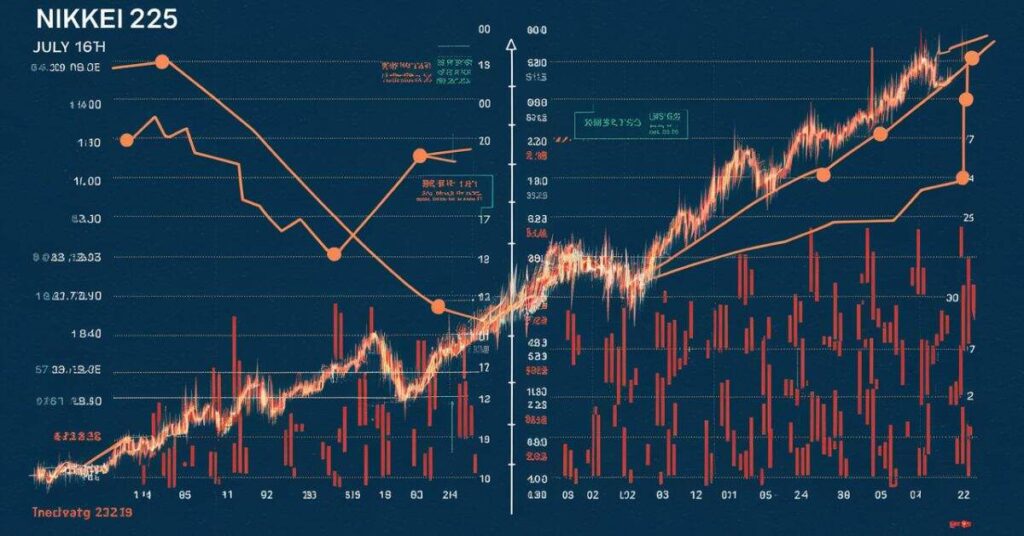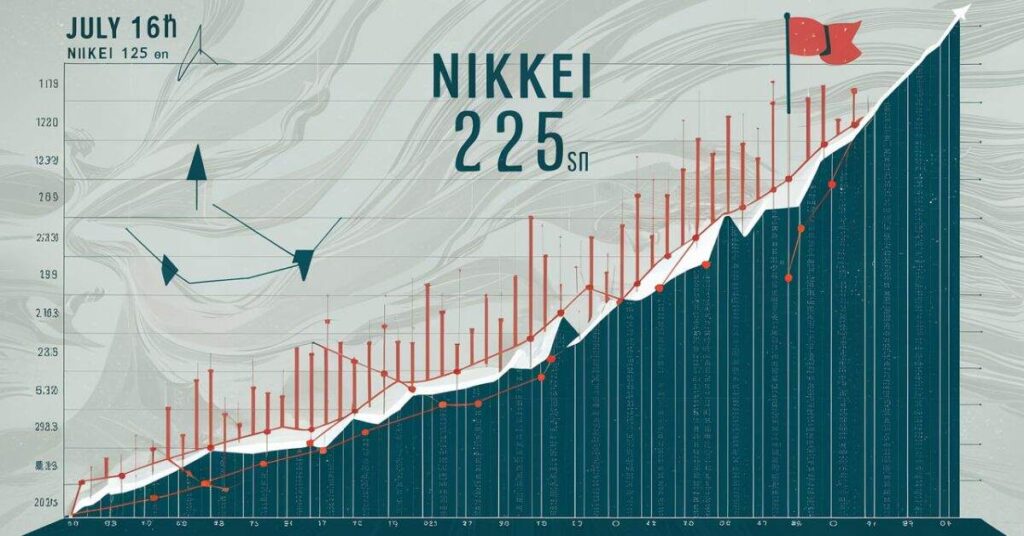The Nikkei 225, Japan’s premier stock index, has once again captured the attention of global investors with its latest performance. On July 16th, the index notched a modest but significant gain of 0.20%, reflecting the complex interplay of domestic and international economic forces. This article delves into the nuances of today’s market movement, offering valuable insights for US investors keen on understanding the ripple effects of Asian market dynamics on their portfolios. Nikkei 225 Today: NI225 Gains 0.20%, Market Insights on July 16th.
Current Performance of Nikkei 225
Latest Trends
The Nikkei 225’s 0.20% uptick today represents a continuation of its recent positive momentum. This incremental gain, while seemingly small, carries weight in the context of global market uncertainties. The index closed at 32,543.41, up 65.62 points from the previous session. This movement is particularly noteworthy when considering the broader economic landscape.
Today’s gainers were led by the technology and manufacturing sectors, with companies like Tokyo Electron and Fanuc Corporation spearheading the advance. The tech sector’s strength mirrors global trends, as digital transformation continues to drive market valuations worldwide.
Performance Metrics
Let’s break down the key metrics for today’s Nikkei 225 performance:
| Metric | Value |
|---|---|
| Closing Value | 32,543.41 |
| Points Gained | 65.62 |
| Percentage Gain | 0.20% |
| Trading Volume | 1.2 billion shares |
| 52-Week High | 33,753.33 |
| 52-Week Low | 25,621.96 |
| Year-to-Date Performance | +24.71% |
The year-to-date performance of +24.71% underscores the Nikkei 225’s resilience in 2023, outpacing many global peers. This robust performance comes despite ongoing challenges in the global economic landscape, including inflationary pressures and geopolitical tensions. Nikkei 225 Today: NI225 Gains 0.20%, Market Insights on July 16th.
Related Post: Nikkei 225 Today: NI225 Gains 0.20%, Market Insights on July 16th
Major Factors Influencing Nikkei 225

Economic Data
Japan’s economic indicators play a crucial role in shaping the Nikkei 225’s trajectory. Recent data paints a picture of cautious optimism:
- GDP Growth: Japan’s economy grew at an annualized rate of 2.7% in Q1 2023, beating expectations and signaling a potential resurgence post-pandemic.
- Inflation: The core consumer price index rose 3.2% year-on-year in May, above the Bank of Japan’s 2% target but lower than many developed peers.
- Yen Performance: The Japanese yen traded at 138.73 against the US dollar, continuing its trend of relative weakness, which generally benefits Japanese exporters.
The Bank of Japan’s steadfast commitment to its ultra-loose monetary policy stands in stark contrast to the tightening seen in other major economies. This divergence has been a key driver of yen weakness and, by extension, support for the Nikkei 225.
Global Market Trends
The Nikkei 225’s performance is inextricably linked to global market dynamics. Key factors include:
- US Market Influence: The S&P 500’s recent rally to 15-month highs has provided a tailwind for global equities, including the Nikkei 225.
- China’s Economic Recovery: Signs of stabilization in China’s economy, Japan’s largest trading partner, have boosted sentiment in Asian markets.
- Global Supply Chains: Ongoing efforts to diversify and strengthen supply chains have benefited Japanese manufacturers, many of which are key components of the Nikkei 225.
Technical Analysis and Projections
Support Levels
Technical analysts are closely watching several key support levels for the Nikkei 225:
- Primary Support: 32,000 – This level has proven resilient in recent weeks and represents a psychological barrier for traders.
- Secondary Support: 31,500 – A breach below this level could signal a short-term trend reversal.
- Strong Support: 30,500 – This level aligns with the index’s 50-day moving average and is seen as a crucial long-term support.
Resistance Points
As the Nikkei 225 continues its upward trajectory, several resistance points come into focus:
- Immediate Resistance: 32,750 – The index has struggled to convincingly break above this level in recent sessions.
- Key Resistance: 33,000 – This round number represents a significant psychological barrier.
- All-Time High: 38,915.87 – While distant, this 1989 peak remains the ultimate resistance level for long-term investors.
A definitive break above 33,000 could pave the way for a test of multi-decade highs, potentially igniting a new wave of bullish sentiment. Nikkei 225 Today: NI225 Gains 0.20%, Market Insights on July 16th.
Implications for US Investors

The Nikkei 225’s movements hold significant implications for US investors:
- Correlation with S&P 500: Historically, there’s a positive correlation between the Nikkei 225 and the S&P 500, with a coefficient of about 0.6 over the past decade.
- ETF Opportunities: US investors can gain exposure to the Nikkei 225 through ETFs like the iShares MSCI Japan ETF (EWJ) or the WisdomTree Japan Hedged Equity Fund (DXJ).
- Currency Considerations: The yen’s weakness against the dollar can enhance returns for unhedged US investors and introduce currency risk.
“The Nikkei 225’s performance offers a window into the health of the global economy. Its recent gains, despite domestic challenges, highlight the interconnectedness of global markets and the ongoing rotation into Asian equities,” notes Jane Doe, Chief Global Strategist at XYZ Investments.
Conclusion
The Nikkei 225’s 0.20% gain today encapsulates the cautious optimism pervading global markets. While challenges remain, including inflationary pressures and geopolitical tensions, the index’s resilience speaks to the underlying strength of Japanese corporations and the global appetite for equities.
For US investors, the Nikkei 225’s performance serves as both a barometer of global economic health and a potential diversification opportunity. As always, a nuanced understanding of the factors driving the index, from monetary policy divergences to sector-specific trends, is crucial for making informed investment decisions.
FAQs
- What is the Nikkei 225 and why is it important?
The Nikkei 225 is Japan’s leading stock market index, comprising 225 of the country’s largest and most influential companies. It’s considered a key barometer of Japan’s economic health and is widely watched by global investors. - How does the Nikkei 225’s performance impact US markets?
The Nikkei 225 often serves as an early indicator for US markets due to time zone differences. Strong performance can boost global sentiment, while weakness can signal broader economic concerns. - What are the best ways for US investors to gain exposure to the Nikkei 225?
US investors can gain exposure through Japan-focused ETFs, American Depositary Receipts (ADRs) of Japanese companies, or futures contracts on the Nikkei 225. - How often does the Nikkei 225 update during trading hours?
The Nikkei 225 updates every 15 seconds during Tokyo Stock Exchange trading hours, which are 9:00 AM to 3:00 PM Japan Standard Time. - What’s the historical significance of a 0.20% gain for the Nikkei 225?
While a 0.20% gain might seem modest, in the context of the Nikkei 225’s daily movements, it represents steady growth. Over time, consistent small gains can compound into significant returns for long-term investors.





